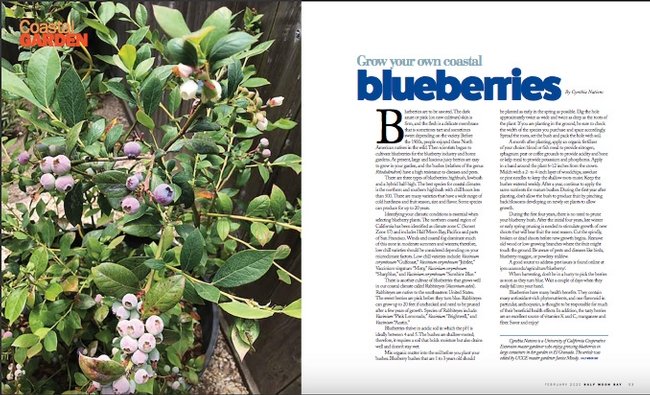Blueberries are to be savored. The dark azure or pink (on new cultivars) skin is firm, and the flesh is a delicate membrane that is sometimes tart and sometimes sweet depending on the variety. Before the 1900s, people enjoyed these North American natives in the wild. Then scientists began to cultivate blueberries for the blueberry industry and home gardens. At present, large and luscious juicy berries are easy to grow in your garden, and the bushes (relatives of the genus Rhododendron) have a high resistant to diseases and pests.
There are 3 types of blueberries: highbush, lowbush, and a hybrid half-high. The best species for coastal climates is the northern and southern highbush with chill hours
Identifying your climatic conditions is essential when selecting blueberry plants. The northern coastal region of California has been identified as climate zone C (Sunset Zone 17) and includes Half Moon Bay, Pacifica, and parts of San Francisco. Winds and coastal fog dominate much of this zone in moderate summers and winters; therefore, low chill varieties should be considered depending on your microclimate factors. Low chill varieties include: Vaccinium corymbosum ‘Gulfcoast,' Vaccinium corymbosum ‘Jubilee,' Vaccinium virgatum ‘Misty,' Vaccinium corymbosum ‘Sharpblue,' and Vaccinium corymbosum ‘Sunshine Blue.'
There is another cultivar of blueberries that grows well in our coastal climate called Rabbiteyes (Vaccinium ashei). Rabbiteyes are native to the southeastern United States. The sweet berries are pink before they turn blue. Rabbiteyes can grow up to 20 feet if unchecked and need to be pruned after a few years of growth. Species of Rabbiteyes include: Vaccinium ‘Pink Lemonade,' Vaccinium ‘Brightwell,' and Vaccinium ‘Austin.'
Blueberries thrive in acidic soil in which the pH is ideally between 4 and 5. The bushes are shallow-rooted; therefore, it requires a soil that holds moisture but also drains well and doesn't stay wet. Mix organic matter into the soil before you plant your bushes. Blueberry bushes that are 1 to 3 years old should be planted as early in the spring as possible. Dig the hole approximately twice as wide and twice as deep as the roots of the plant. If you are planting in the ground, be sure to check the width of the species you purchase and space accordingly. Spread the roots, set the bush, and pack the hole with soil.
A month after planting, apply an organic fertilizer of your choice: blood or fish meal to provide nitrogen, sphagnum peat or coffee grounds to provide acidity, and bone or kelp meal to provide potassium and phosphorus. Apply in a band around the plant 6-12 inches from the crown. Mulch with a 2-4 inch layer of woodchips, sawdust, or pine needles to keep the shallow roots moist. Keep the bushes watered weekly. After a year, continue to apply the same nutrients for mature bushes. During the first year after planting, don't allow the bush to produce fruit by pinching back blossoms developing on newly set plants to allow growth.
During the first 4 years, there is no need to prune your blueberry bush. After the initial 4 years, late winter or early spring pruning is needed to stimulate growth of new shoots that will bear fruit the next season. Cut the spindly, broken, or dead shoots before new growth begins. Remove old wood or low-growing branches where the fruit might touch the ground. Be aware of pests and diseases like birds, blueberry maggot, or powdery mildew. A good source to address pest issues is: https://www2.ipm.ucanr.edu/agriculture/blueberry/
When harvesting, don't be in a hurry to pick the berries as soon as they turn blue. Wait a couple of days when they easily fall into your hand. Blueberries have many health benefits. They contain many antioxidant-rich phytonutrients, and one flavonoid in particular, anthocyanin, is thought to be responsible for much of their beneficial health effects. In addition, the tasty berries are an excellent source of vitamins K and C, manganese, and fiber. Savor and enjoy!
Cynthia Nations is a UCCE Master Gardener who enjoys growing blueberries in large containers in her garden in El Granada. The article was edited by UCCE Master Gardener, Janice Moody.
Attached Images:
